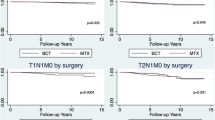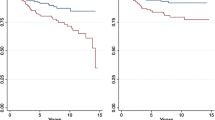Abstract
Background.Three important events in the history of breast cancer treatment occurred between 1983 and 1995: a large clinical trial, first lady Nancy Reagan's choice of mastectomy and the publishing of an NIH consensus statement.
Objective.To assess the effects of these events on use of breast conserving surgery (BCS).
Research design.Data from the cohort study of the surveillance, epidemiology and end results (SEER) Program from 1983 to 1995 were divided into four periods: Baseline, Trial, Celebrity, and Consensus.
Subjects.Of the women, 169,466 diagnosed with early stage breast cancer in nine SEER areas.
Measures.Monthly percentages of BCS.
Results.A linear regression model generated a separate intercept and slope term for four time periods, adjusting for demographic characteristics of breast cancer patients. For the Baseline, Celebrity and Consensus Periods, slopes indicated an increasing use of BCS which varied between 0.24% and 0.28% per month. Slopes for these three periods were not statistically different (p = 0.120). In contrast, there was no change in use of BCS during the trial period (p = 0.247). We tested the magnitude of discontinuity between periods. At the beginning of the trial, celebrity and consensus periods, there were increases in BCS of 5.54% (p < 0.001), −3.55% (p < 0.001), and 2.37% (p < 0.001), respectively.
Conclusions.The use of BCS was substantially affected by the reports of a clinical trial of BCS and by celebrity action. These effects were abrupt but transient. The NIH consensus statement stimulated a small change in use of BCS and may be an important intervention for maintaining the increasing trend in use of BCS since the 1990s.
Similar content being viewed by others
References
Veronesi U, Saccozzi R, del Vecchio M, Banfi A, Clemente C, De Lena M, et al.: Comparing radical mastectomy with quadrantectomy, axillary dissection, and radiotherapy in patients with small cancers of the breast. N Engl J Med 305: 6–11, 1981
Sarrazin D, Le M, Rouesse J, Contesso G, Petit JY, Lacour J, et al.: Conservative treatment versus mastectomy in breast cancer tumors with macroscopic diameter of 20 millimeters or less. The experience of the Institut Gustave-Roussy. Cancer 53: 1209–1213, 1984
Fisher B, Bauer M, Margolese R, Poisson R, Pilch Y, Redmond C, et al.: Five-year results of a randomized clinical trial comparing total mastectomy and segmental mastectomy with or without radiation in the treatment of breast cancer. N Engl J Med 312: 665–673, 1985
Seligmann J. Cancer: a radical departure. Newsweek March 25, p. 91, 1985
Saving breasts: less surgery for tumors. Time March 25, p. 62 1985
Clark RM, Wilkinson RH, Mahoney LJ, Reid JG, Mac Donald, WD: Breast cancer: a 21-year experience with conservative surgery and radiation. Int J Radia Oncol Biol Phy 8: 967–979, 1982
Bluming AZ: Treatment of primary breast cancer without mastectomy. Review of the literature. Am J Med 72: 820–828, 1982
Amalric R, Santamaria F, Robert F, Seigle J, Altschuler C, Kurtz JM, et al.: Radiation therapy with or without primary limited surgery for operable breast cancer: a 20-year experience at the Marseilles Cancer Institute. Cancer 49: 30–34, 1982
Osborne MP, Ormiston N, Harmer CL, McKinna JA, Baker J, Greening WP: Breast conservation in the treatment of early breast cancer. A 20-year follow-up. Cancer 53: 349–355, 1984
Steinberg MD, Juliano MA, Wise L: Psychological outcome of lumpectomy versus mastectomy in the treatment of breast cancer. Am J Psych 142: 34–39, 1985
Veronesi U, Banfi A, del Vecchio M, Saccozzi R, Clemente, C, Greco M, et al.: Comparison of halsted mastectomy with quadrantectomy, axillary dissection, and radiotherapy in early breast cancer: long-term results. Eur J Cancer 22: 1085–1089, 1986
Clark RM, Wilkinson RH, Miceli PN, Mac Donald WD: Breast cancer. Experiences with conservation therapy. Am J Clin Oncol 10: 461–468, 1987
Mann BA, Samet JM, Hunt WC, Key CR, Goodwin JM, Goodwin JS: Changing treatment of breast cancer in New Mexico from 1969 through 1985 JAMA 259: 3413–3417, 1988
Samet JM, Hunt WC, Lerchen ML, Goodwin JS: Delay in seeking care for cancer symptoms: a population-based study of elderly New Mexicans. J Natl Cancer Inst 80: 432–438, 1988
Kantorowitz DA, Poulter CA, Sischy B, Paterson E, Sobel, SH, Rubin P, et al.: Treatment of breast cancer among elderly women with segmental mastectomy or segmental mastectomy plus postoperative radiotherapy. Int J Radia Oncol Biol Phy 15: 263–270, 1988
Fisher B, Redmond C, Poisson R, Margolese R, Wolmark NX, Wickerham L, et al.: Eight-year results of a randomized clinical trial comparing total mastectomy and lumpectomy with or without irradiation in the treatment of breast cancer. N Engl J Med 320: 822–828, 1989
Sarrazin D, Le MG, Arriagada R, Contesso G, Fontaine FX, Spielmann M, et al.: Ten-year results of a randomized trial comparing a conservative treatment to mastectomy in early breast cancer. Radiotherapy Oncol 14: 177–184, 1989
Veronesi U, Salvadori B, Luini A, Banfi A, Zucali R, Del Vecchio MX, et al.: Conservative treatment of early breast cancer. Long-term results of 1232 cases treated with quadrantectomy, axillary dissection, and radiotherapy. Ann Surg 211: 250–259, 1990
Veronesi U, Banfi A, Salvadori B, Luini A, Saccozzi R, Zucali RX, et al.: Breast conservation is the treatment of choice in small breast cancer: long-term results of a randomized trial. Eur J Cancer 26: 668–670, 1990
NIH Consensus Conference: Treatment of early-stage breast cancer. JAMA 265: 391–395, 1991
Kosecoff J, Kanouse DE, Rogers WH, McCloskey L, Winslow, CM, Brook RH: Effects of the National Institutes of Health Consensus Development Program on physician practice. JAMA 258: 2708–2713, 1987
Kosecoff J, Kanouse DE, Brook RH: Changing practice patterns in the management of primary breast cancer: Consensus Development Program. Health Serv Res 25: 809–823, 1990
Sherman CR, Potosky AL, Weis KA, Ferguson JH: The Consensus Development Program. Detecting changes in medical practice following a consensus conference on the treatment of prostate cancer. Int J Tech Assess Health Care 8: 683–693, 1992
Lomas J, Anderson GM, Domnick-Pierre K, Vayda E, Enkin, MW, Hannah WJ: Do practice guidelines guide practice? The effect of a consensus statement on the practice of physicians. N Eng J Med 321: 1306–1311, 1989
Thamer M, Ray NF, Henderson SC, Rinehart CS, Sherman CR, Ferguson JH: Influence of the NIH Consensus Conference on Helicobacter pylori on physician prescribing among a Medicaid population. Med Care 36: 646–660, 1998
Lazovich D, White E, Thomas DB, Moe RE, Taplin S: Change in the use of breast-conserving surgery in western Washington after the 1990 NIH Consensus Development Conference. Arch Surg 132: 418–423, 1997
Lamar JV: I guess it 's my turn. Time October 26, p. 36, 1987
Let's just hold hands. Newsweek. October 26, p. 28, 1987
Nattinger AB, Hoffmann RG, Howell-Pelz A, Goodwin JS: Effect of Nancy Reagan's mastectomy on choice of surgery for breast cancer by US women. JAMA 279: 762–766, 1998
Ries LAG, Kosary CL, Hankey BF, Miller BA, Harras A, Edwards BK: SEER Cancer Statistics Review, 1973–1994. Bethesda, MD: National Cancer Institute; 1997. NIH Publication No. 97–2789
National Cancer Institute: The SEER Program Code Manual. Revised ed. NIH Publication No. 94–1999. Bethesda, MD: National Cancer Institute; 1994.
Cox, DR, Wermuth N: A comment on the coefficient of determination for binary responses. Am Statistician 46: 1–4, 1992
SAS Institute Inc: SAS/STAT User's Guide, Version 6, Fourth Edition, Volume 2, Cary, NC: SAS Institute Inc., 1989, P864
Fisher B, Montague E, Redmond C, et al.: Comparison of radical mastectomy with alternative treatments for primary breast cancer. A first report of results from a prospective randomized clinical trial. Cancer 39(6): 2827–2839, 1977
Rutkow IM, Zuidema GD: Surgical rates in the United States: 1966–1978. Surgery 89: 151–162, 1981
McGuire WL, Donegan WL, Fisher B, Hayward JL: Optimal surgical approaches to the local management of early breast cancer. A panel discussion. Breast Cancer Res Treat 6: 101–112, 1985
Rissanen PM: A comparison of conservative and radical surgery combined with radiotherapy in the treatment of stage I carcinoma of the breast. Br J Radiol 42: 423–426, 1969
Crile G, Jr: Conservative treatment of advanced breast cancer. Am J Surg 126: 343–344, 1973
Fisher B: United States trials of conservative surgery. World J Surg 1: 327–330, 1977
Calle R, Pilleron JP, Schlienger P, Vilcoq JR: Conservative management of operable breast cancer: ten years experience at the Foundation Curie. Cancer 42: 2045–2053, 1978
Foster RS, Jr., Farwell ME, Costanza MC: Breast-conserving surgery for breast cancer: patterns of care in a geographic region and estimation of potential applicability. Ann Surg Oncol 2: 275–280, 1995
Ganz PA, Schag AC, Lee JJ, Polinsky ML, Tan SJ: Breast conservation versus mastectomy. Is there a difference in psychological adjustment or quality of life in the year after surgery? Cancer 69: 1729–1738, 1992
Tarbox BB, Rockwood JK, Abernathy CM: Are modified radical mastectomies done for T1 breast cancers because of surgeon's advice or patient's choice? Am J Surg 164: 417–420, 1992
Wallis C: Was this operation necessary? Time November 2, p. 78, 1987
Lazovich DA, White E, Thomas DB, Moe RE: Underutilization of breast-conserving surgery and radiation therapy among women with stage I or II breast cancer. JAMA 266: 3433–3438 1991
Farrow DC, Hunt WC, Samet JM: Geographic variation in the treatment of localized breast. N Engl J Med 326: 1097–1101, 1992
Nattinger AB, Gottlieb MS, Veum J, Yahnke D, Goodwin JS: Geographic variation in the use of breast-conserving treatment for breast cancer. N Engl J Med 326: 1102–1107, 1992
Nattinger AB, Gottlieb MS, Hoffman RG, Walker AP, Goodwin JS: Minimal increase in use of breast-conserving surgery from 1986 to 1990. Med Care 34: 479–489, 1996
Samet J, Hunt WC, Key C, Humble CG, Goodwin JS: Choice of cancer therapy varies with age of patient. JAMA 255: 3385–3390, 1986
Greenfield S, Blanco DM, Elashoff RM, Ganz PA: Patterns of care related to age of breast cancer patients. JAMA 257: 2766–2770, 1987
Silliman RA, Guadagnoli E, Weitberg AB, Mor V: Age as a predictor of diagnostic and initial treatment intensity in newly diagnosed breast cancer patients. J Gerontol 44: M46–50, 1989
Wetle T: Age as a risk factor for inadequate treatment. JAMA 258: 516, 1987
Ganz PA: Treatment options for breast cancer – beyond survival. N Engl J Med 326: 1147–1149, 1992
Fennell ML, Warnecke RB: The Diffusion of Medical Innovations: An Applied Network Analysis. New York: Plenum Press, 1988
Chu KC, Tarone RE, Kessler LG, Ries LA, Hankey BF, Miller BA, et al.: Recent trends in US breast cancer incidence, survival, and mortality rates. J Natl Cancer Inst 88: 1571–1579, 1996
Rogers EM: Diffusion of Innovations. 4th edn. New York: Free Press; 1995
Du XL: Increase in the use of breast-conserving surgery. JAMA 282: 326–327, 1999
Du XL, Freeman JL, Freeman DH, Syblik DA, Goodwin JS: Temporal and regional variation in the use of breast conserving surgery and radiotherapy for older women with early stage breast cancer from 1983 to 1995. J Gerontol (Med Sci) 54: 474–478, 1999
Nattinger AB, Mc Auliffe TL, Schapira MM: Generalizability of the surveillance, epidemiology, and end results registry population: factors relevant to epidemiologic and health care research. J Clin Epidemiol 50: 939–945, 1997
Rights and permissions
About this article
Cite this article
Du, X., Freeman, D.H. & Syblik, D.A. What drove changes in the use of breast conserving surgery since the early 1980s? The role of the clinical trial, celebrity action and an NIH consensus statement. Breast Cancer Res Treat 62, 71–79 (2000). https://doi.org/10.1023/A:1006414122201
Issue Date:
DOI: https://doi.org/10.1023/A:1006414122201




